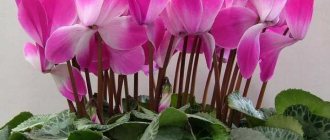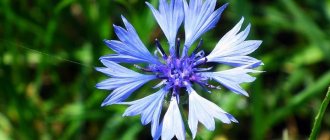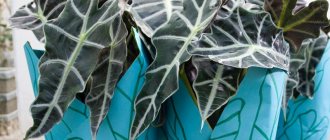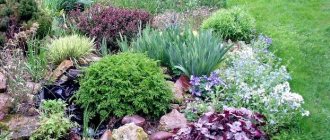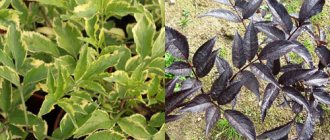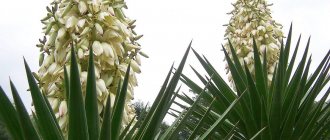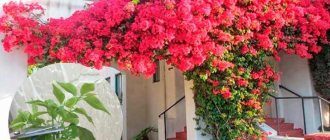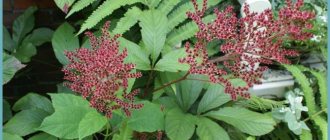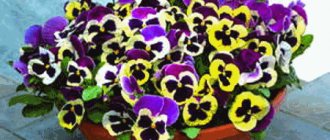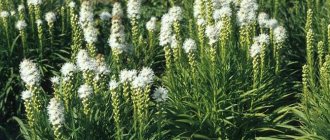Koleria: care and cultivation at home
Watering
The watering regime for Kaleria is moderate - once a week (but more frequent in the heat). The soil layer should not be too dry
It is important to observe the measure and avoid over-moistening or drying out. Excess moisture threatens rotting of the roots, which react sharply to excess water.
Water needs to be at room temperature, always settled (ideally use rain or melt water). Water should not be poured on the leaves.
When watering, water should not get on leaves and flowers.
Top dressing
Feeding Kaleria is highly desirable during the period of growth and flowering. You can use special fertilizers for Saintpaulias or orchids, but diluted 2 times more than recommended in the instructions.
Recent entries English rose varieties with strong resistance to powdery mildew and black spotFrom Gagarin to Jackie Chan: Garden flower varieties named after famous people7 varieties of unpretentious barberry that can be planted in any soil

Orchid fertilizers can be used to feed Kaleria.
It is also possible to use any fertilizer for flowering indoor plants. Kaleria is fertilized once a month in spring and summer. During the dormant period, no feeding is required.
Crown formation
The Kaleria bush can be formed at the discretion of the owner. The plant can be “directed” along different paths and get an ampelous (hanging) or erect bushy plant. Trim the shoots before buds begin to form with sharp, disinfected scissors. The cut off tops can be used to create a new independent plant. To get an ampelous plant, you do not need to prune - the elongated shoots will begin to hang down under their own weight.
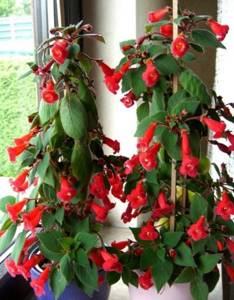
One way to position long shoots is to install a support
Flowering and dormancy
Kaleria blooms in summer, fades in September and prepares to retire until next spring. After flowering, all flower stalks and dried flowers should be removed. The foliage remains on the plant, so the bush can be left in the same place, only by lowering the temperature to 16–18°C. Feeding stops, watering becomes less frequent.

During the dormant period, it is necessary to provide a lower temperature and reduce watering
There are types of Kaleria that fade with the end of flowering. Then all above-ground parts of the plant are cut off, leaving the rhizome in the pot. It is left in a dark, cool (about 13°C) place. It remains there until January, periodically the ground needs to be watered so that the roots do not dry out.
Table: how care errors manifest themselves and what to do to correct the situation
| Problem | Cause | What to do |
| Leaves turn yellow and curl | Light too bright, direct sunlight, air too dry. | Protect from direct sunlight. Spray the air around the plant more often. |
| Does not bloom or produces few flowers | Lack of light, few nutrients, cold or hot, waterlogging. | Move to another, more illuminated place, adjust the temperature and the regime of fertilizing and watering. |
| Brown spots on leaves | Water got in while spraying. | It is not the leaves that need to be sprayed, but the air around the plant. Water can also get on the leaves when watering. In this case, you can use bottom watering - pour water into a tray and place the pot on it. |
| Rot | Excess moisture in the soil. | Replant Kaleria. |
| Leaves dry out and become deformed | Aphid. | Manual collection. |
| Spider mite. |
| |
| Brown spots on leaves | Watering with too cold water. | When watering, you must use settled water at room temperature. |
Home care
In addition to a well-equipped microclimate, appropriate care will also be required. The plant must not only be properly watered and fed, but also ensure a timely transition to the resting phase. Otherwise, the next generation of flower will be weak, with low immunity to adverse factors.
Watering
During the active growing season (beginning of spring - end of autumn), the plant needs regular watering. On average, koleria is watered about 1-2 times a week so that the moisture completely wets the entire substrate and reaches the lower horizons of the soil. In spring and autumn, water is added less frequently, about once a week, but at the height of the summer heat, the frequency of watering can be increased to 3 procedures.
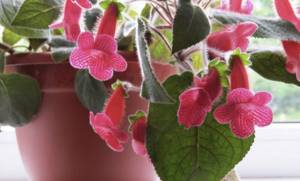
For irrigation, use settled, soft water at room temperature. Salts are harmful to this species, so if possible, water for irrigation should be freed from calcium and magnesium salts (passed through a water filter). Kohleria also responds well to rainwater, but it must be heated to room temperature and left for several days.
When watering, only the soil is moistened; the flower itself should not be irrigated to avoid rotting. Traditionally, top watering is used to moisten the soil, but the optimal moisture regime in the soil is observed only if top watering is alternated with bottom watering.
Fertilizer application
Regular feeding is the only measure that can ensure long-term flowering for the flowers. To do this, fertilizers are applied to the flowerpot every week throughout the entire active growing season (from mid-spring to mid-autumn). Absolutely any complex fertilizer for flowering species can be used as fertilizing. It is applied in liquid form, instead of the next watering procedure.
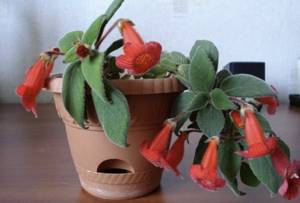
In this case, such mixtures must be diluted twice as much as recommended by the manufacturer, otherwise the substances may damage the delicate root system of the plant.
Important! During dormancy, it is forbidden to fertilize the koleria, since substances accumulated in the soil will inhibit the growth of seedlings or lead to the death of the rhizome
Crown formation
Pruning and crown shaping are optional procedures, but they cannot be avoided if you want to get an aesthetically valuable plant. Pruning and shaping are carried out periodically, about 1-2 times a month or as needed.
Basic rules of procedure:
- the plant is cut with a sharp knife or pruning shears; pinching is prohibited, as it causes excessive damage to delicate tissues;
- The most intensive pruning and shaping is carried out in the spring; in the summer the frequency of procedures is reduced;
- the crown must be formed in early spring, otherwise the koleriya will turn into a dense bush;
- pinch the top when the plant is no more than 20-30 cm long, this activates the growth of lateral branches;
- dried leaves and parts of the stem are cut off immediately, as they spoil the overall appearance and effectiveness of the flower;
- The last pruning is carried out after flowering, when at least half of the plant begins to wither. At this time, the entire above-ground part is removed, after which the koleria goes into hibernation.

Transfer
Coleria transplantation is carried out no more than once every 2-3 years. The ideal period for transplantation is early spring. At this time, the flower awakens from winter dormancy and is able to safely get used to new conditions. Any well-fertilized soil for actively growing species is often used as a substrate. Moreover, such soil must have high water and gas permeability, as well as a neutral pH value. You can prepare the soil yourself; to do this, mix peat, turf soil, leaf soil and river sand (2:1:1:1).
Read more about how to properly and when to replant indoor plants.
The new container must be 3-4 cm in diameter larger than the old one, otherwise the procedure will be ineffective. You should also not choose excessively large pots, as this can lead to color suppression. A vessel made of any materials is suitable for replanting, but traditionally garden pots made of plastic or ceramics are used for this.
Main stages of transplantation:
- Wash the new container thoroughly under running water.
- Treat the pot with a 1% solution of potassium permanganate, and then rinse it with clean water and dry.
- If necessary, sterilize the new soil by heating it in the oven for 20 minutes (temperature +125°C).
- Place a 2-3 cm drainage layer of fine gravel on the bottom of a clean pot. After this, fill the gravel with soil in a layer of 2–4 cm.
- Carefully pull the plant out of the pot along with the soil and place it in a new container.
- Fill the gaps between the old soil and the new soil, then compact and water thoroughly.
Other plant species and varieties
We continue our acquaintance with the collection and present several more interesting specimens.
Kohleria silver feather
This is a unique variety that has foliage of a silvery pearlescent hue. The plates are medium and quite wide. The flowers are small, pubescent. They are colored orange-yellow and strewn with small dots of a reddish tone.
Kohleria ampallang
A variety with large pink flowers. The neck is light. It is abundantly strewn with large burgundy dots. In relation to the buds, the leaves are small. They are elongated in shape with pronounced veins. This is a compact variety that is often grown in apartments and private houses. With proper care, the bush will delight you with colorful and abundant flowering.
Kohleria magnifica
The shoots are also straight with small reddish hairs. The leaves are not matte, like most varieties, but slightly shiny. Outwardly, they resemble quilted fabric. The buds are large. The flowers are orange in color with small red dots and thin stripes that are directed inside the pharynx.
Kohleria undersized
This variety is native to the mountains of Ecuador. The shoots are whitish in color. The leaves are lanceolate, slightly elongated. Their length can reach 7 cm and width - 2 cm. The color is dark green with a silver tint. The height of the bush does not exceed 30 cm.
As for the flower stalks, they grow up to 6 cm in length. They can be either single or open into several axils in which buds are formed. Medium sized flowers. They are bell-shaped. Their maximum length can reach about 1 cm. The tube is white, and the petals are light yellow. Zev is a little different. It is lightly covered with brown dots.
Kohleria hirsuta
Its homeland is Central America. This bush differs from others in its many shoots and unusually colored leaves. The plates are ovoid in shape with a sharp tip. On both sides they are painted dark green with a purple border. As with all species, the leaves are pubescent and have a bronze tint.
The buds differ in both shade and shape. This variety has sunny yellow flowers and petals. Their inner part is covered with reddish dots. The loose buds have a long shape without bends.
Koleria spica
One of the most unusual low-growing species. The birthplace of this flower is Mexico. The bush grows both in the natural environment and at home up to 30 cm in height. The leaves of this color are bluish-gray and long. At the end they are sharp and abundantly covered with fibers.
The flowers of this variety are orange-scarlet. Inside, the open buds are yellowish with red dots.
Koleria Linden
Kohleria lindeniana is native to the highlands of Ecuador. The height of the bush does not exceed 30 cm. The shoots are straight, unbranched. They are abundantly covered with snow-white hairs. The leaves are narrow, slightly elongated. Their lower part is pale, and the upper part is rich green with lines. The flowers reach 2-3 cm long. The outer side is painted in a lavender tone, and the inner side is yellow with brown dots. This variety blooms in autumn.
Koleria foxgloves
Koleria has a large bush, the height of which can reach 80 cm. Young shoots are erect, but every year they slightly bend downwards. Leaves are opposite. They are painted in a pale green shade. The length of a plate of this color can reach 12 cm, and the width – 5 cm.
The flowers of the plant are bell-shaped. Its outer side is white with lilac stripes. As for the inside, it is pale green with splashes of purple.
Woolen koleria
This species is native to Mexico. The maximum height of the bush is 50 cm. The stem is quite thick and massive. The leaves are large, covered with stripes that are located along the veins. All parts of the plant located above the ground are pubescent.
Types and varieties of houseplants koleria
Blooms in spring and summer. The flowering period extends for several months. During this time, the plant does not fade or lose color. Flowers grow on an axillary peduncle from 1 to 3 pieces. The flower tube can be up to 5 cm in length. The corollas themselves resemble bell flowers - they are narrow at the base and widen towards the throat. Has 5 petals.
Koleria is a low herbaceous plant whose stems and leaves are covered with soft hairs. The leaves are located opposite each other, they have an oval shape, slightly tapering towards the edge. They can reach 15 cm in length and almost 10 cm in width. Some species have olive leaves with light veins, while others have emerald-colored leaves with purple inserts. There are also some hybrid species whose leaves have a silver or bronze tint.
The flowers are red, orange with yellow dots on the limb. There are also pink flowers with dark pink splashes and snow-white petals or brown petals with white and yellow dots.
The plant has fleshy, scaly rhizomes in which water and nutrients are accumulated and stored.
Domestic flowers called koleria belong to the Gesneriaceae family. The plant is native to the tropics of Central and South America and the island of Trinidad. Some species are common in Mexico.
There are more than a dozen species of this plant. Most suitable for indoor conditions:
"Bogota Koleria" (K. bogotensis), "Linden's Koleria" (K. lindeniana)
“Coleria foxglove” (K. digitaliflora), “Coleria pleasant” (K. amabilis).
It is these types of koleria flowers that tolerate low-sunny winters better than their relatives and are colorful and compact enough to please the eye indoors.
The "Bogota" species reaches more than half a meter in height. The leaves are wide, oval, about 5 cm in length. Their peculiarity is the variegated edge along the edges of the leaves. The flowers are reddish-orange.
The birthplace of the Lindineda species is Ecuador. This species is no more than 30 cm in height. The stems are covered with light bristles, and several buds bloom on the peduncle at once.
The indoor plant of the species “Coleria foxgloves” has white shoots with dense pubescence. The white-pink flowers have a green throat covered with rich red dots. More than a dozen flowers can grow on one stem.
“Pleasant” species has a distinctive feature - very wide leaves, which can be up to 10 cm in length. But the most interesting thing about them is the color. The silver-green hue is eye-catching. The flowers, on the contrary, hardly attract attention - small pink buds with crimson dots.
There are several dozen varieties of the Koleria plant. The most interesting are the following:
Collection Ganymede, Collection Karl Lindberg
Kohleria Red Ryder,Koleria Amabilis.
Ganymede variety is distinguished by its miniature size. Small leaves - up to 4 cm with a slight brown tint. The flowers are also miniature, not 1-1.5 cm in length. Bright red buds grow profusely and can bloom several times a year.
Karl Lindberg has fairly large purple flowers. The width is about 3 cm. The throat is covered with dark ruby dots. The bud itself is covered in large silvery hairs. The leaves are not very large and have a rich green color.
Look at the photo, it shows the Red Ryder variety. Its distinctive feature is its very large buds:
The tube itself is deep red, the petals are a bright garnet color, and the throat is white and pink. The variety is quite compact. In addition, the flowers grow densely on the bush.
The Amabilis species has fairly large flowers, up to 5 cm. The buds themselves are bright with a light throat, the outer surface is pink. The petals are covered with crimson dots. The leaves are 2 times larger than the buds, their color is dark green, and the hairs create a silvery tint. They also bloom very thickly and for a long time.
Selected varieties of Colombian beauty
As for hybrid plant varieties, their diversity is determined mainly by the variety of flower shades, as well as the duration of flowering. It is worth noting that with proper care, koleria can bloom almost all year round.
Queen Victoria
The species has bright red flowers in the form of a tube. The petals are pink in color with a pink border and interspersed with a beetroot shade.
Bibbi
Scarlet flowers with delicate white petals. In addition, the inflorescences are decorated with splashes of cherry blossom. The leaves of this variety are quite fluffy and have a calm green tint.
Koleriya Varshevich
This one is distinguished from other species by its large lilac buds with yellow petals. Brown inclusions on the petals.
Jester
A plant with large crimson flowers with a light rim at the entrance to the pharynx. The petals are strewn with red dots merging into stripes.
Red Ryder
Large fluffy flowers with a red tube and fiery petals. At the same time, the inner surface of the pharynx is decorated with cherry dots. The leaves are large, velvety and slightly pointed.
General information
The herbaceous flowering plant Koleria belongs to the Gesneriev family and constitutes a separate genus consisting of sixty-five species.
The origin and natural growth is in the hot climates of North and South America, where it occurs as a flower or subshrub.
The genus is named after the nineteenth-century Swiss scientist Kohler. In Europe, it is cultivated as a home ornamental plant and is rarely planted in gardens and personal plots.
What it looks like:
- Artificially grown bushes of different sizes. They are conventionally divided into standard, compact and miniature.
- The root system of the plant is tuberous and is located close to the surface of the earth.
- The stems, or flower stalks, are thin, rigid, grow vertically, and are colored green or purple.
- The leaf blades have an opposite leaf arrangement and a heart-shaped shape. The edge of the leaf is jagged, the surface is covered with thick soft reddish or white hair on both sides.
- The color is usually green with splashes of purple, but there are varieties with bronze, silver, olive and dark green leaves.
- Noticeable large veins, depending on the variety, come in different colors, but are always lighter than the main color of the leaf.
- The leaf sizes are usually up to fifteen centimeters along the larger axis and up to eight centimeters along the smaller one.
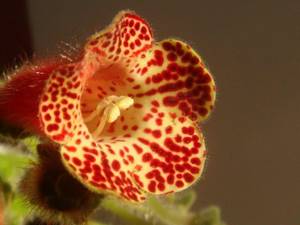
Flowers
- Flowers are of primary decorative value. They grow from the axils of the leaves on a short peduncle, singly or in groups of two or three flowers. Their number on one bush is quite significant.
- The shape is bell-shaped with a tube measuring up to five centimeters. Under the flowers grows a green bract with six toothed lobes.
- The five-petalled corolla consists of semi-oval lobes with edges curving downwards. The throat is always different from the main color; it is most often white or yellow.
- The petals are painted in a variety of color combinations with numerous inclusions of various shapes. You can find red flowers with an orange tint, covered with dark red spots and a yellow throat.
There are species with pink petals with dark specks and a white throat. Some hybrids are colored red along the entire length of the tube with three light yellow petals and two red petals, covered with brown dots.
Cultivation by crossing different species added golden, green, cherry, amethyst and others to the main colors.

Kinds
Kohleria amabilis (pleasant)
A low-growing compact bush with wide wedge-shaped green leaves covered with silver hair. The veins are distinguished by a lighter color, along which the leaf blades have brown stripes. Small two-centimeter pink flowers are covered with crimson dots at the top of the petals.
Kohleria digitaliflora (foxglove)
The shoots are straight, vertically growing and reaching up to eighty centimeters in height; they lie down as they develop. The bush is quite branched, the root system is shallow and scaly. The heart-shaped leaves are green with darker patches along the veins and are quite large.
The flowers have different colors, grow singly, or are grouped in twos or threes. The three upper petals are yellow with a green tint, the two lower ones are dark crimson. The flower tube is three centimeters long, tapering towards the throat. The stems, peduncles, leaves and flowers are densely covered with white hair.
Kohleria eriantha (furry colored)
Tall species with half-meter branched stems. The leaves are dark green, covered in reddish hair with a jagged edge. The structure is loose, velvety. Two petals of the flower are colored red, three – orange. There are numerous yellow dots on the bends of the petals. The length of the tube reaches five centimeters.
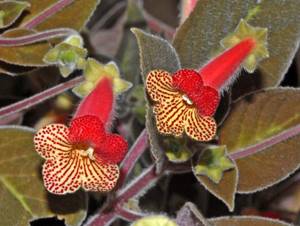
Types of colors
Kohleria bogotensis
These herbaceous perennial plants grow on rocky soil in Colombian forests and reach 60 cm in height. Straight shoots do not branch and are covered with red and white hairs. The leaves are either wide ovate or oval-heart-shaped - grow up to 7.5 cm in length and up to 3.5 cm in width; jagged edges, pointed; The dark green upper part of the leaf is pubescent along the veins with variegated white hairs. Drooping axillary flowers are arranged singly or in pairs on five-centimeter pubescent pedicels. The corolla tube reaches 2.5 cm in length, reddish and pubescent on the outside, and red-orange underneath; with red stripes and specks inside the yellow throat. Blooms profusely from mid-summer to early autumn.
Kohleria magnifica
The stem is covered with red hairs; the leaves seem to be quilted, shiny, covered with white hairs. The dark streaks on the large red-orange flowers extend straight into the throat.
Kohleria hirsuta
This variety has bronze-colored leaves and red tubular flowers on the outside with a yellow throat speckled with bright red.
Kohleria spicata
This Mexican plant is very small, with elongated leaves and red flowers with an orange throat, attached to long stems.
Kohleria lindeniana
Lives in the highlands of Ecuador. The shoots of this herbaceous perennial plant are pubescent with white hairs, and the flower itself grows up to 30 cm in height. The ovoid leaves grow up to 7 cm in length and up to 2 cm in width; green with a pinkish tint below and with white-silver or light green veins on the dark green upper leaf plate. On a 6-centimeter peduncle there are several or single axillary flowers. The corolla is shaped like a bell; the corolla tube, like the flower petals, is a maximum of 1 cm in length. The tube is covered with white hairs, pure yellow inside and with brown speckles at the throat, which in turn is white outside and has purple stripes on the bends. The period of abundant flowering for Linden's flowers is early to mid-autumn.
Foxglove / Kohleria digitaliflora
This herbaceous perennial plant grows primarily in Colombian forests. Kohleria is densely covered with white hairs, the shoots are straight. The leaves have the shape of an ellipse (ovate or lanceolate), grow up to 18-20 cm in length and up to 10-12 cm in width. Green leaves on short petioles are covered with hairs - more densely at the bottom than at the top. There are 5 or more flowers on the axillary inflorescences. The corolla tube is white with a pink tint at the top and grows up to 3 cm in length; There are purple dots on the bend of the green throat of the corolla. Active flowering period: late summer – early autumn.
Kohleria inaequalis
Slightly pubescent medium-sized kohleria. The flowers of this species are red-orange in color, and the limb lobes are light red and covered with dark dots.
Kohleria amabilis
These herbaceous perennial plants grow in the Colombian mountains at an altitude of 800 meters above sea level. Red or green shoots, pubescent with white hairs, grow up to 60 cm in length. Petioles up to 2.5 cm. Leaves grow oppositely and are egg-shaped, reaching 7 cm in width and 10 cm in length; green or dark green above and light green below, with white-silver lines and red-brown veins. The flowers are axillary, pubescent on the outside, with a pink corolla tube - pure white or white with purple spots at the throat. Blooms almost all year round.
Kohleria eriantha
The leaves of this variety have red edges, are velvety and dark. The flowers are large and pubescent, red-orange in color, and the lower lobes of the limb are covered with thick yellow specks.
Kohleria tubiflora
In Colombia and Costa Rica, this variety grows up to 60 cm in height. The leaves are long and oval, red below and dark green above. Orange and red flowers reach a length of 2.5 cm.
Kohleria lanata
This is a Mexican herbaceous plant. The stem is strong. The leaves are small, oval, abundantly covered with fawn hairs, crenate along the edges. The corolla tube is red-orange with light crimson dots covering the lobes of the wide-open limb. Domestic kohleria looks fluffy due to the cover of small hairs covering the entire plant.
Features of flower care
Continuous growth and flowering is the main feature of the color. All this indoor plant requires is a warm, draft-free room and moderate but fairly regular watering.
Watering and humidity The plant needs to be watered from spring to autumn. Important: The water should be soft and settled, and in the hot season, drying out of the soil should be avoided. The soil should be constantly moist, but moderately - stagnation of water in a pot or tray should be avoided
In winter, the plant should be watered carefully and rarely, as the top layer of soil dries. To increase the humidity that koleria loves, you need to spray the air around the leaves. Water should not get on the plant itself, since the leaves have a velvety structure and can become covered with brown spots if they get wet.
Lighting and temperature
The most suitable temperature for keeping kohleria is 20-25C. In winter, the temperature may drop, but not significantly, to 15-20 C. Lighting is required diffused, without direct sunlight. The flower needs light not only before lunch, but also in the afternoon. It is best if the pot with the plant is located on the east or west window of the apartment. In winter, it is advisable to place an additional source of lighting next to the flower, since if there is insufficient lighting, the leaves may lose their brightness.
Substrate and transplantation. The plant needs to be replanted as needed, in the spring, if the roots of the kohleria have entwined the earthen ball. The soil mixture should be formed from peat, sand, leaf and turf soil in proportions of 2:1:1:1. Add charcoal to the substrate, which will absorb excess moisture.
Coleria propagation. This plant can be propagated by both cuttings and seeds. When propagating from cuttings, sections of stems or cuttings with leaves are rooted. In addition, you can divide the flower bush in the spring into several more modest plants. And the most effective way to propagate the Colombian beauty is by sections of rhizomes. The root is divided in early spring and buried in the soil to a depth of two centimeters. Within a few days, ground shoots appear.
Difficulties of care. The leaves of the flower may die after a long period of flowering. In this case, you need to wait until the plant dries completely and cut it off at the very base. Then, periodically moistening the substrate, wait for the rhizome to resume growth. If the color is very elongated, it means it does not have enough lighting. Move the pot to another window or add an additional light source.
Find out more details about caring for koleriya at home here.
Flowering plant

At home, Kaleria experiences periodic vegetative periods. Active growth occurs from the beginning of spring, after reaching long daylight hours; with proper care, flowering continues almost all summer, until the beginning of autumn. It is recommended to pluck faded buds, as they take away some of the nutrients. Then the plant enters the dormant stage, which can be seen by its characteristic wilting. At this point, you need to reduce all care procedures.
Caring for colonies at home
Koleria is unpretentious, blooms profusely, and even a novice gardener can create comfortable conditions.
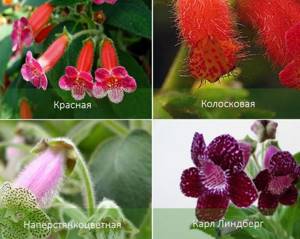
Koleriya is taken out into the open air only in summer. The flower is grown as an ampel flower, but can be formed into a bush if desired. Growing and lodging stems are pinched. Shorten the top by one third with a height of 20-30 cm with a disinfected tool before the formation of buds and cut off the tops.
This is necessary to awaken the buds and form new buds on the side shoots.
In the fall, the wilted parts are removed and moved to a cool room for hibernation.
Transplantation and soil
The flower is replanted once a year, the best time is the end of March or the beginning of April using the transshipment method
Carefully move the bush into another, wide and shallow pot. The earth is not shaken off
The soil is taken nutritious, loose, with low acidity, mixing turf and leaf soil, and also adding peat and sand (1: 2: 1: 1). Another option is sand with humus, turf and leaf soil equally, add small pieces of charcoal. Beginning flower growers purchase a ready-made substrate for violets.
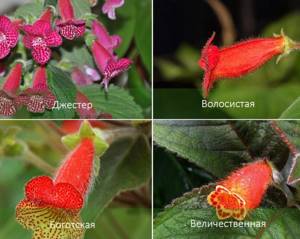
The pot you choose is plastic, but ceramic is better. It is more stable and retains moisture longer; select a container with drainage holes; place 2 cm pieces of brick, pebbles, and expanded clay on the bottom.
Reproduction
Flower growers use the following propagation methods: cuttings, leaves, division of rhizomes, seeds.
Propagation at home by cuttings is simple: cut off the upper part of the shoot, place it in a mixture of sand and leaf soil, taken equally. Treat with a growth stimulator (Kornerost), heat the container from below. Moisten the soil, add Fitosporin to the water to prevent rotting, cover with glass or a cut plastic bottle with a part where the cork is. Ventilate regularly. After rooting, after two weeks they are replanted separately. They can also be rooted in a bowl of water.
The plant is treated in the same way with its leaves. The torn leaf is placed into 1-2 cm of water, adding a stimulant.
Seeds are propagated from mid-winter to the end. It is better to purchase them in a special store. Place the seed in prepared soil made of peat and sand, water it, cover it, and do not cover it with soil. Set the temperature to + 20…+24 °C. Ventilate every day as soon as shoots appear in 2-3 weeks. After the appearance of four normal sheets, they dive.
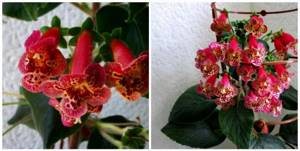
New shoots and roots are formed from rhizomes. An adult plant is removed from the soil and divided into several parts (usually three). Each should have two healthy shoots. The cut areas are sprinkled with charcoal and allowed to dry. Each is planted in a cup with prepared soil. Deepen it to 2-3 cm, cover it, and regularly water it with warm water.
Reproduction of koleria
Seed and vegetative propagation is possible (cuttings, rhizome division).
Growing from seeds
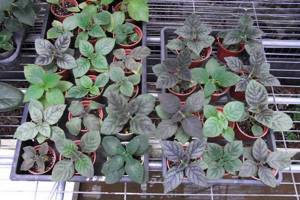
Coleria from seeds photo seedlings
To obtain seeds, cross-pollination is necessary. Sow them in spring in a peat-sand mixture. Moisten the soil, distribute the seeds over the surface without deepening them. Cover the crops with transparent film or glass and place in a bright, warm place. Expect germination in 2-2.5 weeks. Ventilate the greenhouse periodically. When 2 true leaves appear, pick up the plants and plant them in separate pots.
Propagation by cuttings
Cuttings can be carried out all year round. Cut the apical cuttings with a sharp knife and root in water or soil (sand and peat 1 to 1). Plant the rooted cuttings in a pot, and when a new pair of leaves appears, pinch the top to stimulate the growth of side shoots.
Reproduction by root division
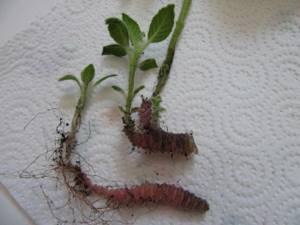
Rhizomes of koleria how to divide photos
Root division is carried out in the spring during transplantation. Remove the plant from the pot, disinfect the knife and divide the rhizome into parts. Treat the cuttings with a fungicide. Plant the roots in separate containers, deepening them by 1.5 cm. Water them periodically and the plant will give new shoots.
The influence of the seasons on the name
Kaleria, born in spring, has a complex character: hot-tempered, straightforward, and can sometimes be rude. The girl seeks knowledge, works hard to achieve what she wants, but does not take other people’s advice and prefers to do everything her own way.
The summer lady is calm, gentle, sincere, vulnerable, romantic, sentimental. Betrayal is hard to bear and he believes in great and pure love. If a loved one is in trouble, he will go to him even to the ends of the earth.

The time of year in which Kaleria was born affects the girl’s character
The autumn young lady is distinguished by her love of freedom and indomitable, bright disposition. Doesn't like to sit still, always on the move. He cannot tolerate gossip and rumors, and never spoils the bones of those around him.
Winter persistently makes dreams come true. She can be capricious, demanding, selfish, and can make fun of anyone. Often quarrels with family and friends. He never changes his decision, even when he realizes that it is wrong.
Reproduction methods
The undemanding nature of Kaleria also lies in the fact that three options for its propagation are available at home. Which is quite rare in exotic tropical plants.
Kaleria can be propagated in the following ways:
- seeds;
- cuttings;
- dividing the rhizome.
Propagation by seeds
Seeds need to be sown in a substrate of leaf soil and sand. There is no need to sprinkle them with soil, just gently spray them with water, then cover them with polyethylene. Containers with caleria seeds should be placed in a warm place. The optimal temperature for germination is 23°C.
When the seedlings sprout, they must be planted at a distance of 2 cm in soil of the same composition. The soil needs to be sprayed regularly. After 1.5 months, the grown plants should be planted again at a distance of 3 cm.
Seedlings can be planted in personal pots when they grow and become stronger. Each Kaleria flower needs a flowerpot with a diameter of 7 cm. The substrate for seedlings consists of the following elements:
- turf soil – 1/2 part;
- leaf soil - 2 parts;
- sand – 1 part;
- peat soil - 1 part.
Before the bush is formed, the tops of the seedlings are pinched to stimulate the development of side shoots.
Cuttings
To propagate Kaleria by cuttings, you need to cut off the top of the shoot and plant it in a container with leaf soil and sand. Moisten the substrate and cover with plastic wrap. The soil needs to be ventilated and watered daily.
Kaleria should take root within 2 weeks. When the young shoot begins to grow, it needs to be transplanted into an individual pot.
Leaves can be used instead of shoots. They must be placed in water or planted in wet sand. But their roots form more slowly, over several months.
Root division
The easiest way to propagate Kaleria at home is by dividing the root. To do this in the spring, when replanting a flower, you need to separate the tuberous roots using a sharp knife. Sprinkle the cut area with charcoal and leave to dry slightly. Then plant them in individual flowerpots. The roots need to be deepened a few centimeters into the soil and watered. After some time, a new plant should grow from each part of the root.
Even a beginner in floriculture can grow an exquisite, unusual, easy to care for and propagate red caleria. If you follow all the rules, it will delight others for a long time with its beautiful and bright flowers.
Possible problems
When growing caleria at home, the following characteristic problems may appear:
- if watering rules are not followed or if water gets on the leaves, small brown spots of irregular shape may appear;
- if the flower is constantly exposed to direct sunlight, yellowing of the leaf plate appears. Sometimes this problem occurs due to overuse of fertilizers;
- due to a lack of mineral and organic compounds in the soil, growth may slow down, as well as buds and flowers falling off;
- When there is insufficient light, Kaleria shoots become bare, leaves and bud ovaries practically do not form.
If you notice and eliminate the cause of the problem in time, the plant quickly recovers and continues to actively grow and form buds. Prolonged exposure to moisture and sunlight can lead to the death of the flower.
